
- Home
- Travel Packages
- Top Destination
-
Travel Attraction
By Category
Top Attraction

- Travel Agents
- Car Rentals
- Hotels
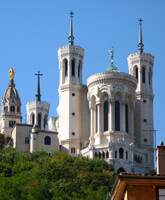
Lyon Cathedral, also known as Cathédrale Saint-Jean-Baptiste de Lyon, is a stunning medieval church in the heart of Lyon, France. It is famous for its remarkable Gothic and Romanesque architecture and its impressive astronomical clock. How to Reach Lyon Cathedral, Lyon The cathedral is centrally located and accessible by various means: By Metro: Take Metro Line D and get off at "Vieux Lyon - Cathédrale Saint-Jean" station. By Bus: Several bus lines stop nearby. By Foot: Located in the Old Town, it's easily reachable from major landmarks. Weather in Lyon Lyon has a temperate climate: Spring (March-May): Mild and pleasant. Summer (June-August): Warm with occasional heatwaves. Autumn (September-November): Cool and sometimes rainy. Winter (December-February): Cold with occasional snow. Timing and Entry Details The cathedral is open daily with free entry, though donations are welcome. Check for specific visiting hours as they may vary. Why is Lyon Cathedral Famous? The cathedral is renowned for: Its impressive astronomical clock from the 14th century. Hosting major historical events, including royal weddings. Its blend of Gothic and Romanesque architecture. History and Architecture Constructed between the 12th and 15th centuries, Lyon Cathedral showcases both Gothic and Romanesque elements. It features intricate stained glass windows and an ornate astronomical clock. Things to Do at Lyon Cathedral Admire the Architecture: Explore its beautiful façade and interiors. See the Astronomical Clock: Witness one of the oldest working clocks in France. Attend a Service: Experience the cathedral's spiritual ambiance. Interesting Facts about Lyon Cathedral It took over 300 years to complete. The astronomical clock dates back to the 14th century. It played a role in various historical events in France. Tips for Visiting Visit in the morning for a peaceful experience. Check for special events and concerts held at the cathedral. Combine your visit with a walk through Vieux Lyon.
Explore More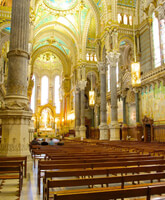
Basilica of Notre-Dame de Fourviere
The Basilica of Notre-Dame de Fourvière is one of Lyon's most iconic landmarks, situated atop Fourvière Hill. It is a stunning example of religious architecture and a major pilgrimage site. How to Reach Basilica of Notre-Dame de Fourvière The basilica can be reached through various transport modes: By Funicular: Take the funicular railway from Vieux Lyon to Fourvière. By Foot: A scenic yet steep climb offering great views of Lyon. By Car: Limited parking is available near the basilica. Weather in Lyon The climate in Lyon varies across the seasons: Spring (March-May): Mild temperatures and blooming flowers. Summer (June-August): Warm and sunny, reaching up to 30°C. Autumn (September-November): Cool and sometimes rainy. Winter (December-February): Cold with occasional snow. Timing and Entry Details The basilica is open daily with free entry, but guided tours may have an additional cost. Why is Basilica of Notre-Dame de Fourvière Famous? The basilica is renowned for: Its magnificent mosaics and stained-glass windows. A blend of Romanesque and Byzantine architectural styles. Being a UNESCO World Heritage site. History and Architecture Built between 1872 and 1896, the Basilica of Notre-Dame de Fourvière was constructed in gratitude to the Virgin Mary, believed to have protected Lyon from wars and plagues. The structure is a blend of Byzantine and Romanesque styles, with elaborate interiors featuring gold mosaics and detailed carvings. Things to Do at the Basilica Explore the Interior: Admire the intricate mosaics and stained-glass windows. Enjoy the Panoramic Views: Get a breathtaking view of Lyon from the basilica’s terrace. Visit the Museum of Sacred Art: Learn about the religious and historical significance of the site. Walk the Nearby Gardens: Relax in the gardens surrounding the basilica. Interesting Facts about Basilica of Notre-Dame de Fourvière The basilica was built as a symbol of gratitude to the Virgin Mary. It is one of the most visited pilgrimage sites in France. The four towers of the basilica symbolize the four cardinal virtues. The crypt beneath the basilica is dedicated to St. Joseph. Tips for Visiting Visit early in the morning to avoid crowds. Wear comfortable shoes if walking up the hill. Take a guided tour to learn about the basilica’s history. Visit at sunset for a magical view of Lyon.
Explore More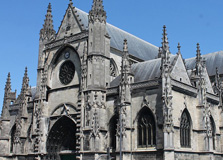
Saint Michel Cathedral, Bordeaux Saint Michel Cathedral, also known as Basilique Saint-Michel, is one of the most important Gothic churches in Bordeaux, France. Recognized as a UNESCO World Heritage site, the cathedral is famous for its soaring bell tower and stunning architectural details. How to Reach Saint Michel Cathedral, Bordeaux The cathedral is located in the heart of Bordeaux and can be reached by multiple transportation options: By Tram: Take Tram Line C and get off at "Saint-Michel" stop, a short walk from the cathedral. By Bus: Several local buses stop near Saint Michel Square. By Foot: It is easily accessible if you are exploring Bordeaux’s old town. Weather in Bordeaux Bordeaux has an oceanic climate, making it pleasant year-round: Spring (March-May): Mild and great for sightseeing. Summer (June-August): Warm with occasional heatwaves. Autumn (September-November): Comfortable temperatures with occasional rain. Winter (December-February): Cool and damp but not extreme. Timing and Entry Details The cathedral is generally open from 10 AM to 6 PM, but timings may vary. Entry is free, though a small fee may be required for guided tours or visiting the bell tower. Why is Saint Michel Cathedral Famous? The cathedral is famous for: Its impressive Gothic architecture. Its bell tower, the tallest in southern France at 114 meters. Its role as a pilgrimage stop on the Santiago de Compostela route. The crypt beneath the tower, which once housed mysterious mummies. History and Architecture Built between the 14th and 16th centuries, the cathedral is a masterpiece of Flamboyant Gothic architecture. The separate bell tower, called the Pey-Berland Tower, stands independently from the main church, a unique feature. Things to Do at Saint Michel Cathedral Explore the Interiors: Marvel at its stained glass windows and vaulted ceilings. Climb the Bell Tower: Enjoy panoramic views of Bordeaux. Visit the Saint Michel Square: Experience the vibrant market and cafés around the cathedral. Attend a Mass: Experience the spiritual ambiance. Interesting Facts about Saint Michel Cathedral The crypt once contained mummified remains, which became a popular attraction. The bell tower was used as a watchtower for centuries. It is one of the largest churches in Bordeaux. Tips for Visiting Visit early to enjoy the peaceful ambiance. Climb the tower on a clear day for the best views. Check for local events and concerts held inside the cathedral.
Explore More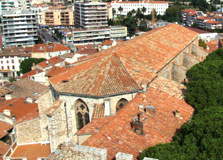
Notre-Dame de l'Espérance is a historic church located in the heart of Le Suquet, Cannes' old town. This stunning 16th-century church is known for its Gothic architecture, peaceful atmosphere, and breathtaking views of the city. It remains one of Cannes' most significant religious and cultural landmarks. How to Reach Notre-Dame de l'Espérance, Cannes You can reach the church through various means: By Air: The nearest airport is Nice Côte d'Azur Airport, about 27 km from Cannes. By Train: Cannes train station is well-connected to major French cities. By Car: Accessible by car, but parking in the old town is limited. By Public Transport: Local buses and taxis provide easy access to Le Suquet, where the church is located. Weather in Cannes Cannes enjoys a Mediterranean climate: Spring (March-May): Warm and pleasant with temperatures around 15-22°C (59-72°F). Summer (June-August): Hot and sunny, reaching up to 30°C (86°F). Autumn (September-November): Mild with occasional rain. Winter (December-February): Cooler but rarely below 10°C (50°F). Timing and Entry Details Notre-Dame de l'Espérance is open to visitors throughout the year. Entry is free, but donations are welcome. It is best to check local listings for any special events or changes in opening hours. Why is Notre-Dame de l'Espérance Famous? The church is famous for its historic significance, impressive Gothic and Renaissance architectural style, and its panoramic views over Cannes. It is also known for hosting concerts and events, especially during the annual musical festival in Cannes. History and Architecture Built in the 16th century, Notre-Dame de l'Espérance stands as a testament to Cannes' rich history. It features a combination of Gothic and Renaissance architectural elements, with a grand bell tower and intricate interior designs. The church played a significant role during times of war and remains a symbol of hope and faith in the region. Things to Do at Notre-Dame de l'Espérance Admire the Architecture: Marvel at the stunning Gothic and Renaissance design. Enjoy Panoramic Views: The church offers one of the best vantage points in Cannes. Attend a Concert: The church hosts music festivals and classical concerts. Explore Le Suquet: Stroll through the historic old town surrounding the church. Interesting Facts about Notre-Dame de l'Espérance The church was built between 1521 and 1627, taking over a century to complete. It features an impressive wooden statue of the Madonna and Child. It was used as a hospital during World War II. Tips for Visiting Notre-Dame de l'Espérance Wear comfortable shoes as you will need to walk uphill to reach the church. Visit in the evening for stunning sunset views over Cannes. Check for concert schedules if you want to enjoy live classical music inside the church.
Explore More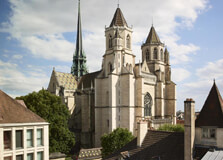
The **Dijon Cathedral**, officially known as the **Cathédrale Saint-Bénigne de Dijon**, is one of the most important and magnificent historical landmarks in the city of Dijon, France. This stunning cathedral, with its fascinating history and striking architecture, is a must-see destination for visitors exploring the Burgundy region. The cathedral's blend of Gothic and Romanesque architectural styles, combined with its rich historical significance, makes it a standout attraction in Dijon. History of Dijon Cathedral Construction of the **Dijon Cathedral** began in the late 13th century and continued for several centuries, resulting in a beautiful combination of Romanesque and Gothic styles. Originally, the site was home to a church dedicated to Saint Benignus, a 3rd-century Christian martyr and the first bishop of Dijon. The current structure was built upon the foundations of the earlier church, with the aim of making the cathedral a significant religious center in Burgundy. Throughout its long history, the cathedral has undergone various renovations and additions. Its construction was largely completed by the 15th century, but the church continued to evolve, particularly its famous **Gothic façade**. During the French Revolution, much of the cathedral’s interior was damaged, but the structure itself remained intact. Architecture of Dijon Cathedral The **Dijon Cathedral** boasts a captivating blend of architectural styles. The exterior of the cathedral features traditional **Romanesque** elements, such as rounded arches, thick walls, and small windows, while the interior reveals the grandeur of **Gothic** architecture with soaring spires and stained-glass windows. One of the most distinctive features of the cathedral is its **tower**, which rises above the city and offers sweeping views of the surrounding area. The cathedral’s façade, adorned with intricate sculptures and statues, is another architectural highlight. The **stained glass windows** of the cathedral depict biblical scenes and are a beautiful representation of the craftsmanship of the era. Inside, the cathedral features a **crypt**, which houses the remains of **Saint Benignus**, as well as relics from the early days of Christianity in the region. Visitors can also admire the **organ**, a stunning example of 18th-century craftsmanship, still used for religious ceremonies and concerts. Why is Dijon Cathedral Famous? The **Dijon Cathedral** is famous for several reasons. Firstly, its historical significance as a religious site dedicated to Saint Benignus, the patron saint of Dijon, has attracted pilgrims for centuries. It is also the seat of the **Archbishop of Dijon**, making it an important center for the Catholic Church in the region. Another reason for its fame is its beautiful and varied architecture. Visitors come from all over the world to admire the **Romanesque-Gothic hybrid style** that is unique to the cathedral. It serves as a stunning example of French ecclesiastical architecture from the medieval and Renaissance periods. Moreover, the cathedral is known for its connection to the **Duchy of Burgundy**, as it was a central place of worship for the nobility and royalty. The **Dijon Cathedral** is not just an important religious landmark but also a symbol of the historical significance of the Burgundy region. How to Reach Dijon Cathedral The **Dijon Cathedral** is located in the heart of Dijon, making it easily accessible for tourists visiting the city. Here’s how to get there: By Public Transport: Dijon has an excellent public transport system, including trams and buses. Visitors can take a tram or bus to the **Place de la Liberation**, which is just a short walk from the cathedral. By Foot: If you're staying in the city center, the cathedral is within walking distance of most major attractions in Dijon. The walk from **Place de la Libération** to the cathedral takes about 5-10 minutes. By Car: If you're driving, there are several public parking areas near the cathedral. However, be aware that parking in the historical center can be limited, so it's recommended to park in nearby parking lots and walk to the cathedral. Weather in Dijon The weather in Dijon is temperate, with four distinct seasons. The best time to visit the **Dijon Cathedral** is during the spring and summer months, from **April to October**, when the weather is mild, and outdoor activities can be enjoyed. In winter, temperatures can drop, but the cathedral remains open for visitors who want to experience its peaceful and serene atmosphere. Regardless of the season, Dijon’s charm and beauty make it a wonderful destination to explore year-round. Timing and Entry Details The **Dijon Cathedral** is typically open to visitors throughout the week. However, it's important to note that the cathedral is an active place of worship, so the visiting hours may be adjusted during religious services or special events. Here's a general overview of the cathedral's visiting hours: Opening Hours: 9:00 AM to 7:00 PM (Monday to Saturday) Sunday Hours: 2:00 PM to 6:00 PM Entry Fee: Entrance to the cathedral is generally free. However, if you wish to visit the crypt or attend a guided tour, a small fee may apply. Things to Do at Dijon Cathedral When visiting the **Dijon Cathedral**, there are several things to do and see: Admire the Architecture: Take time to appreciate the cathedral's unique blend of Gothic and Romanesque architecture. Don’t forget to look up at the intricate ceiling and stunning stained-glass windows. Visit the Crypt: The crypt of **Saint Benignus** is a must-see. It’s an important historical and religious site in Dijon. Attend a Mass: If you're in Dijon on a Sunday, consider attending a mass at the cathedral to experience the peaceful atmosphere of this religious site. Climb the Tower: For panoramic views of Dijon, climb the cathedral's tower, which offers breathtaking views of the surrounding area and the city’s rooftops. Facts and Tips about Dijon Cathedral Did you know? The cathedral is home to an impressive **17th-century organ**, which is still used during mass and musical performances. Tip: Make sure to bring your camera to capture the beautiful architecture, especially the detailed stone carvings and the majestic exterior of the cathedral. Tip: If you're visiting during the summer months, consider attending one of the **concerts** held in the cathedral, as it provides a unique and atmospheric experience. Respect the Space: As an active place of worship, remember to be respectful when visiting. Modest attire is appreciated, and silence is expected during religious services.
Explore More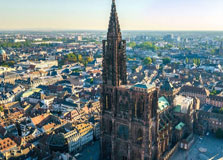
Notre Dame Cathedral, also known as Strasbourg Cathedral, is one of the most magnificent examples of Gothic architecture in Europe. Its breathtaking façade, intricate sculptures, and astronomical clock make it a must-visit landmark in Strasbourg, France. How to Reach Notre Dame Cathedral, Strasbourg There are multiple ways to reach the cathedral: By Tram: Take Tram Line A or D and get off at the "Langstross/Grand'Rue" stop. By Bus: Several bus lines have stops near the cathedral. By Car: There are parking options available nearby, including the "Parking Gutenberg" garage. By Foot: Located in the city center, the cathedral is easily accessible on foot. Weather in Strasbourg Strasbourg experiences a temperate oceanic climate: Spring (March-May): Mild temperatures with blooming flowers. Summer (June-August): Warm and pleasant, perfect for sightseeing. Autumn (September-November): Cool weather with vibrant fall colors. Winter (December-February): Cold, with chances of snow, adding to the charm of the Christmas markets. Timing and Entry Details The cathedral is open to visitors every day: Opening Hours: 7:00 AM - 7:00 PM Entry Fee: Free for general access; a small fee applies for the tower climb. Why is Notre Dame Cathedral, Strasbourg Famous? The cathedral is renowned for its stunning Gothic architecture, its astronomical clock, and its towering spire, which was the tallest in the world for over 200 years. The light show during the evening also makes it a popular attraction. History and Architecture Built between the 12th and 15th centuries, the cathedral is a masterpiece of medieval craftsmanship. The intricate façade is adorned with detailed sculptures, while the interior features stunning stained glass windows and an impressive rose window. Things to Do at Notre Dame Cathedral, Strasbourg Admire the Astronomical Clock: A remarkable timepiece with moving figures. Climb to the Viewing Platform: Offers panoramic views of Strasbourg. Explore the Interior: Marvel at the stained glass windows and Gothic sculptures. Attend a Mass: Experience the cathedral’s spiritual ambiance. Interesting Facts about Notre Dame Cathedral, Strasbourg It was the tallest building in the world from 1647 to 1874. The astronomical clock is one of the most advanced of its time. It inspired Victor Hugo, who described it as a "gigantic and delicate marvel." Tips for Visiting Visit early to avoid crowds. Wear comfortable shoes if planning to climb the tower. Check for special events and light shows. Photography is allowed but flash is not permitted inside.
Explore More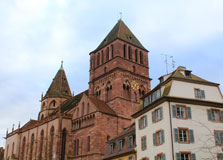
St. Thomas Church in Strasbourg is a remarkable Protestant church known for its impressive Gothic architecture and historical significance. It is an important religious and cultural landmark that attracts visitors due to its stunning interior, notable artworks, and connection to famous composers like Mozart. How to Reach St. Thomas Church, Strasbourg The church is easily accessible through multiple transportation options: By Tram: Take Line A or D and get off at the "Langstross/Grand Rue" stop. By Bus: Several bus routes stop nearby, making it convenient for visitors. By Car: Parking is available at nearby public parking lots. By Foot: The church is located in the historic center and is a short walk from other key attractions. Weather in Strasbourg Strasbourg experiences a temperate oceanic climate: Spring (March-May): Mild temperatures with blooming flowers. Summer (June-August): Warm with average highs around 25°C (77°F). Autumn (September-November): Cool with beautiful fall foliage. Winter (December-February): Cold with occasional snow, ideal for winter tourism. Timing and Entry Details The church is open for visitors throughout the year: Opening Hours: 10:00 AM - 6:00 PM (may vary on religious holidays). Entry Fee: Free entry, but donations are appreciated. Why is St. Thomas Church Famous? St. Thomas Church is famous for its unique blend of Romanesque and Gothic architecture, its role as a Protestant church, and its impressive mausoleum dedicated to Marshal Maurice de Saxe. It is also renowned for its magnificent Silbermann organ, played by Wolfgang Amadeus Mozart in 1778. History and Architecture Dating back to the 12th century, St. Thomas Church showcases a combination of Romanesque and Gothic elements. Unlike many Strasbourg churches, it remained a Protestant place of worship after the Reformation. The church features a five-nave hall design, impressive stained glass windows, and the famous Renaissance-style mausoleum of Marshal Maurice de Saxe. Things to Do at St. Thomas Church Admire the Silbermann Organ: One of the most famous pipe organs in Europe. Explore the Mausoleum of Maurice de Saxe: A striking marble monument by Jean-Baptiste Pigalle. Attend a Concert: The church hosts classical music performances. Appreciate the Architecture: Observe the detailed sculptures and stained-glass artistry. Interesting Facts about St. Thomas Church The church is the main Lutheran church in Strasbourg. Its Silbermann organ was played by Mozart during his visit to the city. It is one of the few churches in Alsace that retained its Protestant identity after the Reformation. Tips for Visiting Visit during the morning hours for a quieter experience. Check for upcoming organ concerts and performances. Respect the religious setting by maintaining silence during services.
Explore More
Notre Dame de Paris is one of the most iconic cathedrals in the world, known for its stunning Gothic architecture, historic significance, and connection to Victor Hugo’s novel The Hunchback of Notre Dame. Located on Île de la Cité in Paris, the cathedral is a must-visit attraction. How to Reach Notre Dame, Paris Notre Dame is centrally located and easily accessible: By Metro: The nearest stations are Cité (Line 4) and Saint-Michel – Notre-Dame (RER B and C). By Bus: Buses 21, 24, 27, 38, 47, 85, and 96 stop near the cathedral. By Foot: It is a short walk from landmarks like the Louvre and Sainte-Chapelle. By Taxi or Car: Parking near the cathedral is limited, so public transport is recommended. Weather in Paris Paris has a temperate oceanic climate: Spring (March-May): Mild temperatures with blooming flowers. Summer (June-August): Warm with occasional rain showers. Autumn (September-November): Cool with colorful foliage. Winter (December-February): Chilly with occasional snowfall. Timing and Entry Details Opening Hours: Typically open from 7:45 AM to 6:45 PM on weekdays and 7:45 AM to 7:15 PM on weekends. Entry Fee: Free entry to the cathedral, but a fee applies to climb the towers. Why is Notre Dame Famous? Notre Dame is famous for: Its Gothic architecture featuring intricate sculptures and stained glass. The historic significance of being the site of coronations and major events. Its association with Victor Hugo’s novel and the legendary Quasimodo. History and Architecture Construction of Notre Dame began in 1163 and was completed in 1345. It features flying buttresses, impressive stained-glass windows, and towering spires. The cathedral suffered damage during the French Revolution but was later restored. The 2019 fire caused severe damage, but restoration efforts are ongoing. Things to Do at Notre Dame Admire the façade with its detailed sculptures. Explore the interior to see the stunning stained-glass windows. Climb the towers for a panoramic view of Paris. Visit the crypt to learn about the site’s history. Interesting Facts about Notre Dame Notre Dame’s bell Emmanuel weighs over 13 tons. It attracts over 12 million visitors annually. The cathedral took nearly 200 years to complete. Tips for Visiting Visit early in the morning to avoid crowds. Wear comfortable shoes if climbing the towers. Check for restoration updates before planning your visit.
Explore More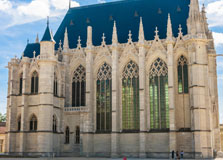
Notre Dame de Paris is one of the most iconic cathedrals in the world, known for its stunning Gothic architecture, historic significance, and connection to Victor Hugo’s novel The Hunchback of Notre Dame. Located on Île de la Cité in Paris, the cathedral is a must-visit attraction. How to Reach Notre Dame, Paris Notre Dame is centrally located and easily accessible: By Metro: The nearest stations are Cité (Line 4) and Saint-Michel – Notre-Dame (RER B and C). By Bus: Buses 21, 24, 27, 38, 47, 85, and 96 stop near the cathedral. By Foot: It is a short walk from landmarks like the Louvre and Sainte-Chapelle. By Taxi or Car: Parking near the cathedral is limited, so public transport is recommended. Weather in Paris Paris has a temperate oceanic climate: Spring (March-May): Mild temperatures with blooming flowers. Summer (June-August): Warm with occasional rain showers. Autumn (September-November): Cool with colorful foliage. Winter (December-February): Chilly with occasional snowfall. Timing and Entry Details Opening Hours: Typically open from 7:45 AM to 6:45 PM on weekdays and 7:45 AM to 7:15 PM on weekends. Entry Fee: Free entry to the cathedral, but a fee applies to climb the towers. Why is Notre Dame Famous? Notre Dame is famous for: Its Gothic architecture featuring intricate sculptures and stained glass. The historic significance of being the site of coronations and major events. Its association with Victor Hugo’s novel and the legendary Quasimodo. History and Architecture Construction of Notre Dame began in 1163 and was completed in 1345. It features flying buttresses, impressive stained-glass windows, and towering spires. The cathedral suffered damage during the French Revolution but was later restored. The 2019 fire caused severe damage, but restoration efforts are ongoing. Things to Do at Notre Dame Admire the façade with its detailed sculptures. Explore the interior to see the stunning stained-glass windows. Climb the towers for a panoramic view of Paris. Visit the crypt to learn about the site’s history. Interesting Facts about Notre Dame Notre Dame’s bell Emmanuel weighs over 13 tons. It attracts over 12 million visitors annually. The cathedral took nearly 200 years to complete. Tips for Visiting Visit early in the morning to avoid crowds. Wear comfortable shoes if climbing the towers. Check for restoration updates before planning your visit.
Explore More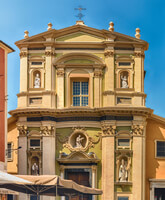
Nice Cathedral, also known as Cathédrale Sainte-Réparate de Nice, is a stunning Roman Catholic cathedral in the heart of Old Nice. This architectural masterpiece is dedicated to Saint Reparata, the patron saint of Nice. It stands as a beautiful example of Baroque design and is an important religious and historical landmark in the city. How to Reach Nice Cathedral There are several ways to reach the cathedral conveniently: By Bus: Local buses such as lines 5, 7, and 14 have stops near the cathedral. By Tram: Take Line 1 and get off at the "Cathedrale - Vieille Ville" stop. By Car: Parking can be difficult in Old Nice, so public transport is recommended. By Foot: Located in the historic center, it is within walking distance of many key attractions. Weather in Nice Nice enjoys a Mediterranean climate, making it a great destination year-round: Spring (March-May): Mild and pleasant. Summer (June-August): Warm and sunny with temperatures around 30°C (86°F). Autumn (September-November): Comfortable with fewer tourists. Winter (December-February): Cool but rarely freezing, making it a peaceful time to visit. Timing and Entry Details The cathedral is open to visitors throughout the week. Opening Hours: 9:00 AM - 12:00 PM and 2:00 PM - 6:00 PM Entry Fee: Free entry for all visitors. Why is Nice Cathedral Famous? Nice Cathedral is renowned for its Baroque architecture, beautiful frescoes, and religious significance. It houses relics of Saint Reparata and is a major site for Christian worship and historical exploration. History and Architecture Originally built in the 17th century, the cathedral has undergone several restorations. The Baroque-style facade is complemented by its richly decorated interior, featuring ten chapels, intricate woodwork, and grand altars. Things to Do at Nice Cathedral Admire the Interior: The detailed frescoes and gilded decorations are breathtaking. Attend a Mass: Experience a traditional service in a historic setting. Explore the Chapels: Each chapel inside the cathedral tells a unique story. Walk Around Old Nice: Discover charming streets and local cafes nearby. Interesting Facts about Nice Cathedral The cathedral is dedicated to Saint Reparata, a young Christian martyr. It was built on the site of a former church that dated back to the 11th century. The cathedral features a grand organ that is used for concerts and ceremonies. Tips for Visiting Visit during the morning hours for a peaceful experience. Dress modestly as it is a place of worship. Photography is allowed, but flash usage is prohibited. Check for any scheduled events or special services before visiting.
Explore More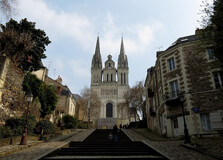
Cathedrale Saint-Maurice d'Angers
The Cathedrale Saint-Maurice d'Angers is a magnificent Gothic cathedral located in the heart of Angers, France. With a history dating back to the 12th century, this cathedral is a fine example of medieval architecture. It is not only a place of worship but also a key historical and cultural landmark in the city. Visitors come to admire its stunning architectural details, stained-glass windows, and the peaceful ambiance it offers. How to Reach Cathedrale Saint-Maurice d'Angers Getting to the Cathedrale Saint-Maurice d'Angers is fairly easy, as it is located in the city center, within walking distance of many other attractions in Angers. Here's how you can reach it: By Train: The nearest train station to the cathedral is the Gare d'Angers Saint-Laud, located around 15 minutes by foot from the cathedral. High-speed trains (TGV) from major cities like Paris, Nantes, and Tours serve this station. By Bus: Various bus lines serve the city center, with stops near the cathedral. The bus terminal is also located at a short distance from the cathedral. By Car: If you are driving, the cathedral is easily accessible by car. There are public parking lots nearby, such as Place du Ralliement or the underground parking at Centre Commercial La Galerie. Weather in Angers Angers enjoys a temperate climate, which means that the weather is generally mild throughout the year. The best time to visit the Cathedrale Saint-Maurice d'Angers is during the spring and autumn months (April to October), when the weather is pleasant for walking around the city. In the summer, temperatures can range from 25°C to 30°C (77°F to 86°F), while winters are cooler, with temperatures dropping to 0°C to 5°C (32°F to 41°F). It rarely snows, but rain showers are common, so it's advisable to bring an umbrella or raincoat. Timing and Opening Hours The Cathedrale Saint-Maurice d'Angers is open to visitors every day, although its hours can vary depending on the season and religious services. Typically, it is open from: Monday to Saturday: 9:00 AM - 7:00 PM Sunday: 10:00 AM - 12:00 PM and 2:00 PM - 6:00 PM (Mass services may affect visiting hours) Be sure to check the official website for updated hours, especially during holidays or religious events when the cathedral may be closed to tourists during Mass. Why is Cathedrale Saint-Maurice Famous in Angers? The Cathedrale Saint-Maurice d'Angers is famous not just for its architectural beauty but also for its significant role in the history of Angers. Some of the reasons it attracts thousands of visitors each year include: Historical Significance: The cathedral has been the site of several key events in the region’s religious history and is a major symbol of Angers' medieval past. Architectural Marvel: Its mix of Romanesque and Gothic styles makes it a true masterpiece, with soaring spires, intricate carvings, and stunning stained-glass windows. Artistic Treasures: Inside, visitors can see beautifully preserved stained-glass windows, an impressive altar, and sculptures dating back to the 13th century. Entry and Visit Details Admission to the Cathedrale Saint-Maurice d'Angers is free for visitors, as it is an active place of worship. However, if you are visiting to see the cathedral's treasures, it's a good idea to take a guided tour to fully appreciate its historical and artistic significance. Guided tours are available in multiple languages and typically last 1 to 1.5 hours. For special exhibitions, concerts, or events, there may be an entry fee, so it's a good idea to check the official website or inquire at the cathedral for the latest information. History and Architecture The Cathedrale Saint-Maurice d'Angers was originally built in the 11th century and later rebuilt in the 12th century. The cathedral’s construction started in the Romanesque style but was eventually completed in the Gothic style, which is visible in its towering spires, pointed arches, and ribbed vaults. The cathedral is dedicated to Saint Maurice, the patron saint of the city of Angers. Notable architectural features of the cathedral include: The Facade: A grand Gothic facade with three large doors adorned with intricate sculptures and carvings. The Nave: The cathedral’s nave is lined with columns and boasts soaring ceilings, creating a sense of awe as you walk through. Stained Glass Windows: The cathedral houses many remarkable stained-glass windows, some dating back to the 13th century, depicting biblical scenes and saints. The Crypt: Below the cathedral lies a crypt, which is one of the oldest parts of the structure, and contains several tombs and relics of past bishops. Things to Do at Cathedrale Saint-Maurice d'Angers While at the cathedral, visitors can: Explore the Interior: Spend time admiring the exquisite stained-glass windows, sculptures, and intricate carvings throughout the cathedral. Attend Mass: If you're visiting on a Sunday, consider attending one of the Mass services to experience the cathedral in its full religious and cultural context. Join a Guided Tour: Learn more about the cathedral’s history and architecture through a knowledgeable guide. Visit the Crypt: Take a tour of the cathedral’s crypt to see the oldest part of the church and its ancient relics. Interesting Facts about Cathedrale Saint-Maurice d'Angers The cathedral was originally built to house the relics of Saint Maurice, who was a 3rd-century Christian martyr. During the French Revolution, many of the cathedral's treasures were looted or destroyed, but much of its original architecture remains intact. The cathedral is a popular venue for concerts, especially classical music performances, due to its excellent acoustics. Tips for Visiting Cathedrale Saint-Maurice d'Angers Dress Modestly: As a place of worship, it's advisable to dress modestly when visiting the cathedral. Avoid wearing hats or shorts, especially if you plan to attend Mass. Respect the Quiet Atmosphere: The cathedral is a peaceful space for reflection and prayer. Maintain a respectful and quiet demeanor when inside. Check for Events: The cathedral often hosts special events, such as organ concerts or religious ceremonies. Make sure to check the schedule before your visit. Bring a Camera: The architecture and stained-glass windows offer fantastic photo opportunities, so don’t forget your camera!
Explore More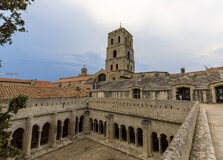
The Saint-Trophime Church (Église Saint-Trophime) is one of the most important landmarks in Arles, France. This magnificent Romanesque church is not only a place of worship but also a symbol of the city's rich history and artistic heritage. Known for its stunning architecture and intricate carvings, the church is a UNESCO World Heritage site, along with other Roman monuments in Arles. With its beautiful portal, peaceful cloister, and historical significance, Saint-Trophime Church attracts visitors from around the world. How to Reach Saint-Trophime Church, Arles Saint-Trophime Church is centrally located in the heart of Arles, making it easily accessible from most parts of the city. Here’s how to reach it: By Train: Arles has a well-connected train station, Gare d'Arles, located approximately 15 minutes on foot from the church. From the train station, you can walk or take a local bus to the church. By Bus: Local buses in Arles are frequent, and the nearest stop to the church is Place de la République, just a short walk from Saint-Trophime. By Car: Arles is easily accessible by car. There are parking facilities near the church, and you can park your vehicle in one of the public parking areas located throughout the city center. Weather in Arles The weather in Arles plays a significant role in the overall experience of visiting the Saint-Trophime Church. Here is a quick overview of what to expect depending on the season: Summer (June to August): Arles experiences hot and dry summers, with temperatures ranging from 25°C to 35°C (77°F to 95°F). Summer is a great time to explore the city, but be sure to wear sunscreen and stay hydrated. Autumn (September to November): The weather cools down, with temperatures ranging from 15°C to 25°C (59°F to 77°F). Fall is perfect for sightseeing, as the crowds are fewer and the weather is mild. Winter (December to February): Winters in Arles are relatively mild, with temperatures averaging 5°C to 15°C (41°F to 59°F). Although the weather is cooler, it’s a quieter time to visit, making it ideal for those who prefer less crowded experiences. Spring (March to May): Spring brings pleasant temperatures ranging from 10°C to 20°C (50°F to 68°F). The mild weather and blooming flowers make it one of the best times to visit Arles. Timing and Opening Hours Saint-Trophime Church is open to visitors throughout the year. However, opening hours may vary depending on the season and religious services. The typical hours are as follows: Summer (April to October): 9:00 AM to 7:00 PM Winter (November to March): 9:30 AM to 5:30 PM The church may be closed or have limited access during religious holidays or special events, so it's a good idea to check the official website or inquire locally for specific dates before planning your visit. Why Famous for Arles? Saint-Trophime Church is famous for its stunning Romanesque architecture, its role in Arles’ religious and historical significance, and its UNESCO World Heritage status. Here’s why it stands out: Architectural Masterpiece: The church is a fine example of Romanesque architecture, characterized by its massive stone structure, rounded arches, and intricate carvings. Its façade is particularly notable for the sculpted portal that depicts biblical scenes and saints. UNESCO World Heritage Site: Along with other monuments in Arles, Saint-Trophime is listed as a UNESCO World Heritage site. It represents an important part of the city’s historical and cultural heritage. Historical Significance: The church was originally built in the 12th century to honor Saint Trophimus, the first bishop of Arles. It played a major role in the development of the Christian community in southern France. Entry and Visit Details Visiting Saint-Trophime Church is a memorable experience, combining both historical exploration and architectural admiration. Here are the essential details for your visit: Admission Fee: The entry fee is typically around €6 for adults. There are discounted rates for students, seniors, and children, usually costing around €4 or less. Free Admission: Admission is often free for children under 12 years old and on certain special days such as European Heritage Days. Guided Tours: The church offers guided tours in several languages. These tours usually last around 45 minutes to an hour and provide detailed insights into the church’s architecture, history, and religious significance. Audio guides are also available for those who prefer a self-guided tour. Accessibility: The church is accessible to visitors with limited mobility, with ramps and support for wheelchair access. However, note that some areas, like the cloister, may have uneven surfaces. History and Architecture Saint-Trophime Church was built in the 12th century and is named after Saint Trophimus, one of the early Christian bishops of Arles. The church was designed in the Romanesque style, characterized by its solid stone construction, rounded arches, and robust features. Its architectural grandeur reflects the importance of Arles during the Middle Ages as a key center for Christianity in the region. The church's most impressive feature is its main portal, which is adorned with detailed sculptures depicting scenes from the Bible, such as the Last Judgment. This portal is a fine example of Romanesque sculpture and a major reason why the church is so well-regarded in architectural circles. Inside, the church is equally impressive with its large nave, beautiful stained glass windows, and serene atmosphere. The cloister, located adjacent to the church, is an oasis of calm, featuring intricate columns and a peaceful courtyard for contemplation. The church’s architectural design and rich history make it a must-see for anyone interested in Romanesque art and religious heritage. Things to Do at Saint-Trophime Church Visiting Saint-Trophime Church is not just about admiring its architecture; there are several activities and things to do while you're there: Explore the Cloister: Don’t miss the beautiful cloister located next to the church. It’s a peaceful area perfect for a moment of reflection, and the intricately carved columns provide a glimpse into the artistry of the time. Admire the Sculptures: Take time to study the elaborate sculptures on the church's main portal, which depicts biblical scenes with exceptional detail. Attend Mass: If you're visiting during a religious service, you can experience the spiritual atmosphere of the church during Mass. It is a remarkable way to connect with the heritage of the place. Photography: The church’s architectural features and serene environment offer ample opportunities for photography. Be sure to capture the stunning exterior as well as the interior details. Interesting Facts about Saint-Trophime Church Saint-Trophime Church was originally a small chapel but was expanded over the centuries to its current grandeur. The church’s main portal is considered one of the finest examples of Romanesque sculpture in southern France. The church has been a major pilgrimage site for centuries, especially for those on the route to Santiago de Compostela in Spain. The church’s bell tower, visible from many parts of Arles, is a famous landmark in the city. Tips for Visiting Saint-Trophime Church Take a Guided Tour: To fully appreciate the church’s history and architecture, consider taking a guided tour. The stories behind the sculptures and the religious significance of the building are best understood with an expert guide. Respect the Space: As Saint-Trophime Church is still a place of worship, visitors are asked to be respectful of the services and the peaceful atmosphere within the church. Visit the Cloister: Don’t miss the chance to visit the cloister, which is often less crowded and offers a tranquil environment for reflection and photography. Check the Event Schedule: If you're interested in attending a religious service or special event, be sure to check the church’s schedule for any upcoming services, concerts, or cultural events.
Explore MoreClassical Spain With Paris 9 Nights - 10 Days Tour
10 Days/ 9 Night
Barcelona - Paris - Madrid - Seville - Granada
France And Swiss Alps 10 Nights - 11 Days Tour
11 Days/ 10 Night
Paris - Lyon - Zurich - Lucerne
European Discovery Classic 11 Nights - 12 Days Tour
12 Days/ 11 Night
Paris - Venice - Florence - Munich - Amsterdam - Innsbruck - Rome - Lucerne
From Madrid To Paris 6 Nights - 7 Days Tour
7 Days/ 6 Night
Barcelona - Paris - Madrid
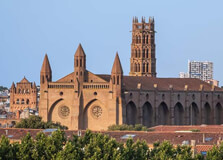
The Church of the Jacobins is one of the most famous and historically significant religious buildings in Toulouse, France. A fine example of Southern Gothic architecture, it is renowned for its stunning design and its association with the Dominican Order, which founded the church in the 13th century. The church is not only a place of worship but also a significant historical and architectural landmark that attracts visitors from around the world. How to Reach Church of the Jacobins The Church of the Jacobins is centrally located in Toulouse, making it easy to reach by foot or public transport. Here are some ways to get there: By Car: The church is located at 1 Place des Jacobins, Toulouse, and there are several parking options around the area, including both public and private parking lots. However, traffic can be heavy in the city center, so public transport is often a more convenient option. By Public Transport: Toulouse's metro system is one of the most convenient ways to reach the Church of the Jacobins. The nearest metro station is Jean-Jaurès (Line A and Line B), which is just a short walk from the church. Several bus lines, including 13, 14, and 27, also stop nearby. By Bicycle: Toulouse is a bike-friendly city with many dedicated cycling paths. The church is accessible by bike, and there are bike racks available for visitors nearby. Weather in Toulouse Toulouse enjoys a Mediterranean climate, which means mild winters and hot summers. The weather can greatly affect your visit to the Church of the Jacobins, especially if you plan to walk around the area or enjoy the church’s outdoor spaces: Spring (March to May): The weather is mild with average temperatures ranging from 12°C to 20°C (54°F to 68°F). Spring is an excellent time to visit the church and explore the beautiful surroundings without the summer crowds. Summer (June to August): Summer temperatures in Toulouse can reach up to 35°C (95°F), so be prepared for the heat if you’re visiting during this time. Early morning or late afternoon is ideal for exploring the church comfortably. Autumn (September to November): Autumn brings cooler temperatures, making it perfect for a visit. Expect temperatures between 15°C and 25°C (59°F to 77°F), and enjoy fewer tourists than in the summer months. Winter (December to February): Winters are mild in Toulouse, with temperatures averaging 5°C to 12°C (41°F to 54°F). While the weather is generally pleasant, the church’s indoor atmosphere offers a welcome break from any colder days. Timings and Opening Hours The Church of the Jacobins is open to visitors most days of the year. The church’s opening hours may vary, especially during religious holidays or special events. Here are the typical visiting hours: Opening Hours: The church is usually open to the public every day from 9:00 AM to 6:00 PM. However, it’s always recommended to check in advance, as religious services or special events may alter these hours. Mass Services: Mass is held regularly at the church, and visitors are welcome to attend. Service times are usually on Sundays at 10:30 AM and on weekdays at 6:30 PM. Why Famous for Toulouse? The Church of the Jacobins is famous for several reasons: Historical Significance: The church was built in the 13th century by the Dominican Order, making it one of the oldest churches in Toulouse. It is closely associated with Saint Thomas Aquinas, who was a Dominican friar and philosopher. His tomb is housed in the church, and it has become a place of pilgrimage for those interested in his teachings. Architectural Wonder: The church is an outstanding example of Southern Gothic architecture. Its unique features, including the impressive ribbed vaults, slender columns, and the iconic palm tree-like pillar, make it one of the most remarkable Gothic churches in France. Cultural Heritage: Over the centuries, the Church of the Jacobins has played a key role in Toulouse's religious and cultural life. Today, it also serves as a space for cultural events, concerts, and exhibitions, adding to its significance in the city's contemporary life. Entry and Visit Details Visiting the Church of the Jacobins is a memorable experience, with both free and paid entry options depending on the areas you wish to explore: Entry Fee: Entry to the church is generally free for visitors, allowing access to the main nave and the central areas. However, certain parts of the church, such as the cloister or special exhibitions, may require a small fee. Guided Tours: To gain a deeper understanding of the church’s history and architecture, you can opt for a guided tour. Tours are available in multiple languages and can be booked in advance. The guided tours typically take around 1 hour. Educational Workshops: The church offers educational workshops, especially for school groups and families. These sessions include interactive learning experiences about the church's history, architecture, and religious significance. History and Architecture of the Church of the Jacobins The Church of the Jacobins was founded by the Dominican Order in 1215 and has undergone several modifications over the centuries. The church was constructed to house the Dominican friars and serve as a place of worship and education. Its construction was largely funded by donations from wealthy Toulouse families, which allowed the church to grow into one of the most important religious sites in the region. Architecturally, the Church of the Jacobins is one of the best examples of Gothic architecture in southern France. The church features impressive stained-glass windows, ribbed vaults, and a unique palm tree-shaped pillar that supports the church's stunning ceiling. This central column is one of the defining features of the church and serves as a visual representation of the Dominican order’s symbolic connection to the tree of life. In addition to its architectural beauty, the church also houses the tomb of Saint Thomas Aquinas, one of the most influential philosophers of the medieval period. His remains were brought to the church in 1369, and the site remains a place of veneration for many religious and academic visitors. Things to Do at the Church of the Jacobins While visiting the Church of the Jacobins, there are several things to do and explore: Explore the Architecture: Take time to appreciate the stunning Gothic architecture, particularly the ribbed vaults, stained glass windows, and the famous palm tree column. Visit the Tomb of Saint Thomas Aquinas: Pay your respects to the great philosopher and theologian at his tomb inside the church. Attend a Concert: The church hosts concerts and cultural events throughout the year, providing an opportunity to experience the church’s acoustics and atmosphere in a unique way. Learn About the History: Explore the historical exhibits and informative displays within the church to understand its significance and role in the religious history of Toulouse. Facts About the Church of the Jacobins The Church of the Jacobins was constructed over a period of 70 years, from 1215 to 1280. The church's architecture is known for its distinct Southern Gothic style, which features tall, slender columns and elaborate ribbed vaults. The tomb of Saint Thomas Aquinas is located in the church, making it a key pilgrimage site for followers of his teachings. The church has also been used for cultural events, including concerts, exhibitions, and conferences, due to its rich acoustics and historical setting. Tips for Visiting the Church of the Jacobins Arrive Early: To avoid crowds, it’s recommended to visit the church early in the morning, especially during peak tourist seasons. Dress Appropriately: As a place of worship, visitors should dress modestly when visiting the church. If you plan to attend Mass, it is advised to wear respectful attire. Check for Special Events: Before your visit, check the church’s website or local listings for any upcoming concerts, exhibitions, or special events that may be of interest. Take a Guided Tour: A guided tour can enhance your experience, providing deeper insights into the history and architectural features of the church.
Explore More